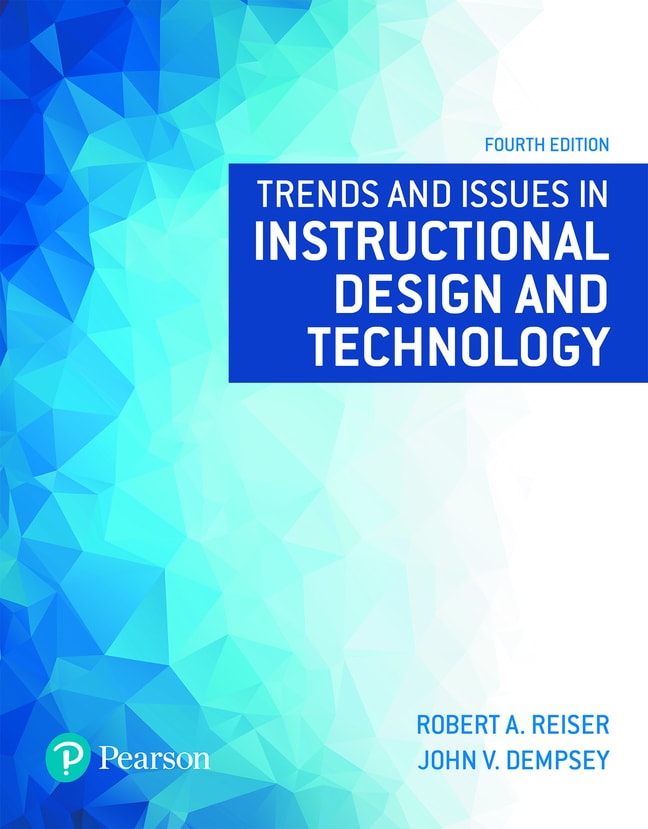
Trends and Issues in Instructional Design and Technology, 4th edition
Your access includes:
- Search, highlight, notes, and more
- Easily create flashcards
- Use the app for access anywhere
- 14-day refund guarantee
$10.99per month
Minimum 4-month term, pay monthly or pay $43.96 upfront
Learn more, spend less
-
Listen on the go
Learn how you like with full eTextbook audio
-
Find it fast
Quickly navigate your eTextbook with search
-
Stay organized
Access all your eTextbooks in one place
-
Easily continue access
Keep learning with auto-renew
Overview
I: DEFINITION AND HISTORY OF THE FIELD
1. What Field Did You Say You Were In? Defining and Naming Our Field -- Robert A. Reiser
2. A History of Instructional Design and Technology -- Robert A. Reiser
II: INSTRUCTIONAL DESIGN MODELS
3. Characteristics of Foundational Instructional Design Models -- Robert Maribe Branch
4. SAM and Pebble-in-the-Pond. Two Alternatives to the ADDIE Model -- Michael W. Allen and M. David Merrill
5. The Successive Approximation Model (SAM). A Closer Look-- Michael W. Allen
III: THEORIES AND MODELS OF LEARNING AND INSTRUCTION
6. Psychological Foundations of Instructional Design -- Marcy P. Driscoll
7. Constructivism for Active, Authentic Learning -- Brent G. Wilson
8. The Learning Sciences. Where They Came from and What It Means for Instructional Designers -- Christopher Hoadley and James P. Van Haneghan
9. Motivation, Volition, and Performance -- John M. Keller and Markus Deimann
IV: EVALUATING AND MANAGING INSTRUCTIONAL PROGRAMS AND PROJECTS
10. Evaluation in Instructional Design. A Comparison of the Major Evaluation Models -- R. Burke Johnson and Angelia Bendolph
11. Measuring the Return on Investment (ROI) in Technology-Based Learning -- Jack J. Phillips, Patricia P. Phillips, and Hope Nicholas
12. An Introduction to Learning Analytics -- Beth Dietz, Janet E. Hurn, Thomas A. Mays, and David Woods
13. Onsite and Virtual Project Management -- Brenda C. Litchfield
V: PERFORMANCE IMPROVEMENT
14. The Development and Evolution of Human Performance Improvement -- Harold D. Stolovitch
15. Performance Support -- Marc J. Rosenberg
16. Informal Learning -- Saul Carliner
VI: IDT IN VARIOUS SETTINGS
17. Instructional Design in Business and Industry -- Monica W. Tracey and Gary R. Morrison
18. Instructional Design Opportunities in Military Education and Training Environments -- Mary F. Bratton-Jeffery
19. Performance, Instruction, and Technology in Health Care Education -- Craig Locatis
20. Integrating Technology into K-12 Education -- Anne Ottenbreit-Leftwich and Thomas Brush
21. Instructional Design in Higher Education -- Brenda C. Litchfield
22. Instructional Design in Europe. Trends and Issues -- Jeroen J. G. van Merrienboer, Begoña Gros, and Helmut Niegemann
23. Instructional Design and Technology in an Asian Context. Focusing on Japan and Korea -- Katsuaki Suzuki and Insung Jung
VII: GETTING AN IDT POSITION AND SUCCEEDING AT IT
24. Getting an Instructional Design Position. Lessons from a Personal History -- Robert A. Reiser
25. Performance Consulting --Catherine Tenzca and Judith Hale
26. Getting Involved in Instructional Design and Technology. Recommendations for Professional Development --
James D. Klein and Nick Rushby
VIII: TECHNOLOGY AND LEARNING
27. E-Learning and Instructional Design -- John V. Dempsey and Richard N. Van Eck
28. Social Media and Instructional Design --Vanessa P. Dennen
29. Mobile Learning -- Clark Quinn
30. The Emergence and Design of Massive Open Online Courses 250 --Curtis J. Bonk, Mimi Miyoung Lee, Thomas C. Reeves, and Thomas H. Reynolds
31. Using Rich Media Wisely -- Ruth Colvin Clark and Richard E. Mayer
IX: INSTRUCTIONAL STRATEGIES
32. Social Interdependence Theory and the Design of High-Quality Learning Experiences--David W. Johnson and Roger T. Johnson
33. Leveling Up. Game Design Research and Practice for Instructional Designers --Richard Van Eck, Valerie J. Shute, and Lloyd Rieber
34. Problem-Based Learning. Essential Design Characteristics -- Peggy A. Ertmer and Krista D. Glazewski
35. Keep It Real. The Benefits of Authentic Tasks in Contemporary Learning Environments -- Jan Herrington and Thomas C. Reeves
X: CURRENT ISSUES IN INSTRUCTIONAL DESIGN AND TECHNOLOGY
36. Professional Ethics. Rules Applied to Practice -- Sharon E. Smaldino, J. Ana Donaldson, and Mary Herring
37. Diversity and Accessibility -- Joél Lewis and Stephen Sullivan
38. The Evolving Economics of Educational Materials and Open Educational Resources. Toward Closer Alignment with the Core Values of Education -- David Wiley, PhD
39. Changing Conceptions of Design -- Elizabeth Boling and Kennon M. Smith
Epilogue -- Robert A. Reiser and John V. Dempsey
Author Biographies
Author Index
Subject Index
Published by Pearson (January 1st 2021) - Copyright © 2018
ISBN-13: 9780137411917
Subject: Curriculum & Instruction
Category: Instructional Design
Your questions answered
When you purchase an eTextbook subscription, it will last 4 months. You can renew your subscription by selecting Extend subscription on the Manage subscription page in My account before your initial term ends.
If you extend your subscription, we'll automatically charge you every month. If you made a one‑time payment for your initial 4‑month term, you'll now pay monthly. To make sure your learning is uninterrupted, please check your card details.
To avoid the next payment charge, select Cancel subscription on the Manage subscription page in My account before the renewal date. You can subscribe again in the future by purchasing another eTextbook subscription.
When you purchase a Channels subscription it will last 1 month, 3 months or 12 months, depending on the plan you chose. Your subscription will automatically renew at the end of your term unless you cancel it.
We use your credit card to renew your subscription automatically. To make sure your learning is uninterrupted, please check your card details.